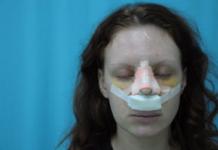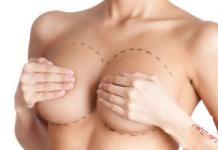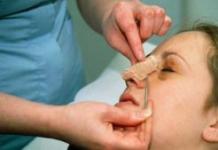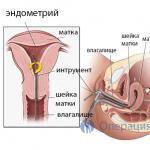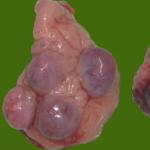But also the patient’s compliance with the rules of rehabilitation.
Features and principles of recovery
During the rehabilitation period, you will need to use medications from certain drug groups:
- painkillers (“ ”, “ ”);
- antiviral;
- antibiotics;
- antiseptics;
- drugs that accelerate the regeneration of the dermis ("", "").
Features of recovery after mammoplasty are described in the video below:
Caring for seams
The seams require special care. To avoid dehiscence, doctors use absorbable materials for suturing. To avoid leaving a wide, very noticeable seam, you need to:
- secure the edges of the wound with a plaster;
- perform antiseptic treatment several times a day;
You can apply smoothing agents to the seams after they have been lightened. If you apply the product to a dark seam, the effect may be the opposite.
What to do with swelling
They are considered an inevitable consequence after mammoplasty. Swelling persists for one to two weeks. In some cases, swelling remains noticeable longer. To eliminate this consequence after surgery, you must follow the following instructions from specialists:
- wear compression garments;
- maintain body weight at the same level;
- wash the postoperative area with warm water. This procedure helps normalize blood circulation;
- adjust your diet. It is necessary to limit the intake of salt and spices that make you want to drink more;
- Avoid overheating the body, preferably stay in a cool room;
- avoid physical contact of the chest with anything other than special underwear.
When is physical activity allowed?
Particular attention should be paid to physical activity during the recovery period. Care must be taken in order to increase the load:
- in the first week of physical Only minimal load is allowed. It is forbidden to raise your arms, carry weights exceeding 3 kg, or perform any sudden movements that involve the upper half of the body;
- You cannot drive a car for 2 weeks after the procedure. If the steering wheel is not equipped with power steering, then you need to stop driving a car for a longer period;
- perform simple physical exercises work can be done after half a month. In this case, you should not make sudden movements or lift heavy objects. Sick leave is closed if the patient is in good health, as well as in the case when the position held requires mental, but not physical labor;
- It is recommended to perform the “cheerful man” exercise to develop the arms and shoulders. The index and middle fingers are moved upward along the vertical surface, small steps should be taken;
- after 3–4 weeks, the doctor may allow you to perform more serious exercises, but only minimal effort is allowed;
- after two months you can go to the gym, work out with dumbbells (after consultation with your doctor).
Breast massage
A mandatory condition for the recovery period is a massage. Doctors usually prescribe it a month after the procedure. There are times when it is advisable to perform a massage earlier. The benefit of a massage course is to accelerate the removal of swelling and improve overall well-being.
Massage prevents the development of capsular contracture (the formation of a hard, thick connective tissue shell around the implant). The connective tissue enveloping the prosthesis must be thin and elastic. It should be supportive and not painful.
The massage should be performed with warm hands. The doctor shows certain techniques that improve blood circulation and soften fibrous tissue. Massage movements (gentle pressure, rocking, stroking) should be performed in the area of the implant base.
Skin care
 The dermis of the breast after mammoplasty is very stretched. It needs various irregularities. To nourish the dermis, masks and creams are used, but the composition of the preparations should not get on the seams.
The dermis of the breast after mammoplasty is very stretched. It needs various irregularities. To nourish the dermis, masks and creams are used, but the composition of the preparations should not get on the seams.
A month after mammoplasty, the following procedures are allowed:
- alginate masks;
- seaweed wraps;
- serum application.
To moisturize, you can use breast enlargement products. They perfectly nourish and moisturize the skin.
Rehabilitation after mammoplasty by day
For the first 24 hours, the patient is under the supervision of resuscitators. This precaution is necessary to prevent complications due to surgery and general anesthesia. If there are no complications, the woman is discharged on the second day after mammoplasty.
The wound after surgery heals within a few days. The process of implant engraftment and breast formation takes longer. This process can take 6 – 8 weeks.
The first 72 hours are considered the hardest. This postoperative period is characterized by a feeling of discomfort in the surgical area, pain, and swelling of the tissues. In the first 2 days, the doctor recommends taking painkillers that have an antipyretic and anti-inflammatory effect:
- Meloxicam.
First
- On the first day, but you can’t go to bed.
- It is advisable to take a sitting, reclining position.
- In the evening (if the patient is feeling normal), she is allowed to get up and walk around.
- You can drink water after 3 hours, and eat food after 5 hours.
Second
- On the second day after mammoplasty, the doctor should examine the patient.
- If necessary, the doctor makes a dressing.
- If everything goes well, hospitalization is no longer required. The patient is sent home with recommendations for recovery.
Third and fourth
- During this period, you need to follow a home regime.
- The patient gradually returns to normal life.
- Walking and good nutrition are recommended. Walking is considered very beneficial.
In this video, the girl talks about her experience of rehabilitation after mammoplasty:
Fifth
- A doctor examines a patient in a clinic.
- If necessary, perform dressing.
- If the healing process goes well, the patient returns home for a whole week.
Twelfth
 If no complications arise, the patient goes for a follow-up examination at the clinic.
If no complications arise, the patient goes for a follow-up examination at the clinic.
6 weeks
The final examination of the patient is carried out. The doctor examines the results of the operation in detail. He must make sure that the client’s sensations have returned to normal so that she can return to a full, active life.
Mammoplasty is an operation that is performed on a woman’s mammary glands. For females, beautiful breasts are a source of pride that gives them self-confidence. This is the part of the body that primarily attracts a man.
The most popular is augmentation mammoplasty, which allows you to change the volume and shape of the breast. There is also breast reduction, this is its reduction and tightening.
The duration of this operation is approximately 2 hours and is performed under general anesthesia.
The services of a plastic surgeon are used by young mothers whose breasts have changed their shape after breastfeeding. Mammoplasty surgery solves all aesthetic problems associated with the mammary glands.
How long does it last
The rehabilitation period is the time after surgery during which the patient must follow certain recommendations in order not to harm the result obtained.
Full recovery after mammoplasty will take approximately two months.
The postoperative wound itself heals within a few days, but the process of implantation and breast formation takes longer, usually within 6-8 weeks.
With augmentation mammoplasty, the recovery period usually takes about 6 weeks. This time is necessary for the implant to be firmly fixed in the woman’s tissues.
Video: Question to a plastic surgeon
What is?
The recovery period after mammoplasty can be divided into two stages.
- First stage– this is an important period, the first three weeks, when you need to almost completely eliminate physical activity. It is necessary to get rid of the strain on the muscles of the shoulder girdle, so it is necessary to constantly wear compression garments both day and night with the tape fastened.
- Second phase– this is the next three weeks, a less strict period, because a slight increase in physical activity is already possible. Sports such as swimming, running are encouraged, you can raise your arms, so it is at this time that the patient feels more confident, and there is no longer any discomfort associated with the surgery.
As a result, six weeks end with the removal of compression underwear, then the woman can choose new underwear for herself, which significantly improves her mood.
Scarring
Scarring after surgery is completely normal.
Large scars can only occur if very large implants were used.



Mammoplasty is a surgical operation, and any operation is stressful for the body, and therefore it is necessary to take a conscious approach when deciding to take such a serious step; very serious attention should be paid to all factors, especially the rehabilitation period.
Of great importance in the success of the operation and obtaining the desired result depends on the choice of the clinic and the doctor. The doctor must be a professional and have extensive experience.

When breast augmentation occurs, the quality of the implants plays a very important role. More complex and traumatic is the operation, which is performed to tighten or reduce the mammary glands.
With this type of surgery, more incisions are made and therefore require a longer recovery period.
- insufficient seam care;
- refusal to wear compression garments;
- Inappropriate physical activity can lead to very undesirable consequences.
The postoperative period depends not only on the qualifications of the doctor and the work he performed, but also to a great extent on how the patient follows all the recommendations.
When preparing for surgery, you should be aware of the importance and be prepared for the fact that you will definitely have to adhere to the rules, and only if you follow all the recommendations will you get the desired result.
How is recovery after mammoplasty going by day?
- The first day after the operation the patient will be under the supervision of a doctor.
So that if complications develop after surgery or anesthesia, you can immediately receive emergency help.
Most likely, you will have to take painkillers for the first few days, since most women experience pain during this period.
Pain is associated with breast swelling, tissue stretching, and muscle damage. The doctor will also prescribe antibiotics to prevent purulent complications.

By the evening, if the patient is in satisfactory condition, you can get up and walk around. After three hours you can drink water, and after five hours you can eat a little.
- On the second day, the doctor examines the patient, and, if necessary, a dressing is done.
If the course is favorable, hospitalization is no longer necessary, and the patient can safely go home, making sure to take with her recommendations for recovery.
- On the third - fourth days, you should follow a home regime.
It is worthwhile to restore the body. Good nutrition and walks will help with this. You can gradually return to your normal lifestyle. It is useful to engage in regular walking.
A careful approach to the restoration process guarantees the absence of complications and proper implantation.
- On the fifth day the patient should come to the clinic for an examination, change the dressing if necessary, and if everything is in order, then she can go home for a week.
- Then, if there are no deviations, then only on the twelfth day the patient will have a follow-up examination in the clinic.
- Six weeks later, the last examination, evaluation of the result of the operation.
During this time, the patient’s sensations returned to normal and she can fully return to a full, active life.
When can you play sports?
During the recovery period, your physical activity should be limited.
During the first week you cannot:
- sleep on your stomach;
- make too sudden movements;
- in particular, it is worth reducing the load on the shoulder girdle;
- You cannot raise your arms above your shoulders or bend over;
- Lifting heavy objects is strictly prohibited.
After a week or a week and a half, you can start doing light housework, but you still can’t lift heavy objects or bend over. It is also not recommended to drive for the first two weeks.
You will have to stop playing sports for a month to avoid displacement of the implant. You will have to avoid sex for a month.
For a few weeks you should take care of yourself and not overexert yourself. You can return to training no earlier than after four weeks, be sure to consult your doctor first.
Loads should be increased gradually, and be sure to wear compression garments during training.
Why do you need compression garments?
Immediately after the operation, the doctor should put on compression garments; it will help the breasts take the correct shape and prevent the implants from moving, and also support the breasts.
Compression garments prevent the implants from moving below the desired level, promote faster fixation and correct breast formation due to a good supporting effect:
- Due to tight fixation, it prevents the sutures from coming apart, and also prevents them from stretching and expanding, blood circulation improves, which helps speed up healing.
- By reducing sensitivity to touch, it helps reduce the severity of postoperative pain.
 Photo: compression garments
Photo: compression garments Compression underwear needs exactly the same care as regular underwear, so you should purchase at least two sets.
Important! You should not immediately switch to regular underwear; the transition should occur gradually, and be sure to consult a doctor first.
In some cases, patients after surgery complain of decreased immunity and poor health. Don’t be scared, because during the rehabilitation period your body will have to adapt to the implants.
Often in the first days, patients feel that breast sensitivity is increased and nipple sensitivity is reduced.
Don't worry about this, after a while everything will go back to normal.
- You should be prepared for the breasts to be hard for the first few months as they get used to their new condition.
- It is recommended to give up alcohol for two weeks.
- You shouldn’t worry about trifles; you need to carefully monitor your health.
The most important things during the recovery period:
- rest;
- proper diet;
- walks in the fresh air and following the doctor’s recommendations.
In this paper we will look at the features of rehabilitation after mammoplasty. Surely many women are dissatisfied with their breasts and strive to change at least something about them. More often this is due to a psychological factor and obsession with one’s appearance. It is necessary to understand that nature has done much better than a plastic surgeon can do.
Very often women face this problem after giving birth. This is due to the fact that after breastfeeding it sags and loses its shape. To restore it to its former elasticity, women are ready to lie down on the operating table. Now we will talk about the features of the operation and the postoperative period.
Mammoplasty
Before we discuss the rehabilitation period after mammoplasty, it is necessary to understand what it is and why it is needed.
Mammoplasty is a surgical procedure that is performed for certain purposes. These include:
- change in shape;
- breast enlargement;
- breast reduction.
The most common purposes of mammoplasty are to reshape or enlarge sagging breasts. In the first case, the plastic surgeon removes excess skin and secures the breasts in their normal position. When enlarging, special prostheses called implants are used. They are implanted under the skin or muscle.
It is also important to know that this procedure has indications and contraindications. The first include:
- asymmetry;
- recovery in case of breast removal;
- macrosopathy;
- micromastia;
- ptosis;
- sagging and breast reduction after breastfeeding;
- gynecomastia.
The latter applies to men. Yes, even men turn to plastic surgeons to undergo mammoplasty. This is necessary for hypertrophied breasts.
Contraindications include:
- oncological diseases;
- infections;
- poor blood clotting;
- diseases of any internal organs;
- breastfeeding (must pass at least a year after the birth of the baby);
- minority.
All this should be taken into account before going to the clinic to change your breasts.
Kinds
Rehabilitation after mammoplasty does not last as long and painful as is commonly believed. We will talk about this in detail later. Now we will look at the types of surgical interventions to change the size or shape of the breast.
In modern plastic surgery, the following types of mammoplasty can be distinguished:
- endoprosthetics;
- reduction plastic;
- mastopexy.
The last operation is divided into two more subtypes:
- isolated;
- combination with prosthetics.
Endoprosthetics is also called augmentation. This operation involves the implantation of special harmless prostheses. It is important to clarify here that the natural function does not fade away.
Reduction plastic surgery is most often popularly called breast reduction. How does the reduction process work:
- removal of excess fat;
- elimination of excess;
- removal of stretched skin.
The last point is necessary to prevent sagging breasts, which often occurs with an impressive bust volume. The surgeon applies stitches only after the shape of the future bust has been finally modeled.
The last type of surgery is a breast lift for sagging breasts. Since removing excess skin does not always bring the desired result, because the breast can take on an irregular shape, surgeons recommend combining this operation with prosthetics. Then the mammary glands will take the correct shape, rise noticeably and be smooth and elastic.
Preparation

The rehabilitation period after mammoplasty does not last so long, if you take into account some of the doctor’s recommendations to properly care for your breasts. Now a little about preparing for the operation. If no contraindications have been identified and you are serious about having surgery, then you need to undergo a series of examinations:
- blood and urine tests;
- blood biochemistry;
- analysis for the presence of hepatitis;
- breast ultrasound examination.
In addition to these examinations, it is necessary not to use hormonal drugs or those containing salicylates two weeks before surgery. People who smoke should give up nicotine a week before surgery. This is necessary so that the rehabilitation period after mammoplasty passes faster and the sutures heal at the same pace as expected. It is important to know that good blood flow is necessary for rapid healing, and nicotine impairs this process.
Operation
The duration of rehabilitation after mammoplasty under the muscle, as in other cases, depends on the location of the incision and compliance with the doctor’s recommendations. The operation itself lasts from one to four hours.

The following options are available for prosthetics:
- subglandular (under the tissue);
- subfascial (installation between fascia and muscle);
- submuscular (under the muscle);
- combined (part of the implant under the muscle, and part under the mammary gland).
Only a surgeon can tell you which option is right for you. As for breast reduction, in addition to the aesthetic aspect, we can also highlight a therapeutic purpose. After breast reduction, the following favorable moments are possible: pain in the spine decreases, breathing becomes easier, pulmonary diseases disappear, physical activity increases and sleep improves.
A breast lift consists of several stages: removal of excess tissue, correct distribution of the areola, and, if desired, installation of implants under the muscle. With a prosthesis, the breasts look more natural.
Postoperative period
If we consider mammoplasties by day, it is better to distinguish periods by weeks or even months. Main stages:
- after three weeks the swelling completely disappears;
- within two months the implant case is formed;
- After six months the feeling of discomfort goes away.
Now briefly about some features of the postoperative period:
- a month of wearing compression garments;
- ban on raising hands for three weeks;
- do not lift weights for three months (more than three kilograms).
The final result will be visible only after three months. You should not evaluate the result before, because the breasts will still change, all inflammatory processes will pass and the mammary glands will take the correct shape.
Seam processing

How long does rehabilitation take after mammoplasty? It is quite difficult to answer, because it all depends on the type of operation and the location of the incision. However, if you take into account the doctor’s recommendations, the healing period and removal of swelling will pass faster. Now about the rules for processing seams. It is worth noting that everyone's healing process is different. Some do not experience any discomfort, but there are also those who seek help from a medical facility.
Necessary activities:
- to prevent the seams from coming apart, rest in a semi-sitting position for the first 24 hours;
- monitor the scarring process;
- on the recommendation of a doctor, treat the stitches with antibiotic ointments;
- in some cases it is worth using brilliant green for processing;
- The first bath can only be taken four days after the operation.
Care

Breasts after mammoplasty require special care. Now briefly about what needs to be done to prevent sad consequences:
- sleep on your back (at least three weeks);
- You can take a shower only on the fifth day after surgery;
- treat seams;
- relieve yourself of physical activity;
- wear compression garments;
- change your underwear daily to prevent infection;
- do not ignore the recommendations of your doctor, he knows better how to care for your breasts in the period after surgery;
- After consulting a doctor, you can use ointments to remove scars.
Physical exercise
Rehabilitation after or another type will go more smoothly if you follow the doctor’s recommendations. One of them is avoiding physical activity.
Please note that you should not engage in any sport until your doctor allows it. It’s worth forgetting about jogging and fitness for a while. Even ask your husband to carry a heavy package from the store. For a month, it is not recommended to raise your arms, much less lift more than three kilograms.
pros

In this section, we propose to consider the advantages of surgical intervention to correct the shape, enlarge or reduce the breast. The advantages include:
- safety of the operation;
- reducing the risk of breast cancer;
- aesthetic appearance.
Scientists have proven that it helps to avoid a fairly common disease among women - breast cancer. The operation is completely safe. If everything went well, then you will be able to delight others with beautiful and firm breasts for a long time.
Minuses

The disadvantages of mammoplasty include:
- rehabilitation period (it is worth considering the fact that the duration of the rehabilitation period increases with the size of the implanted implant);
- nausea after anesthesia;
- pain that is relieved with analgesics;
- possible insomnia;
- remaining scars (if properly cared for, this side effect can be avoided);
- changing your lifestyle (giving up active sports and going to the gym);
- quitting cigarettes;
- refusal to plan pregnancy (at least six months);
- During breastfeeding, you should take more careful care of your nipples.
Unsatisfactory result
We looked at rehabilitation after mammoplasty under the muscle by days, or rather, months. In that section it was said that the final result should be assessed only after three months. What to do if the result is unsatisfactory?
Unsuccessful plastic surgery can occur for the following reasons:
- due to the fault of the doctor;
- low quality implant;
- rejection of the implant by the body.
To avoid this, you need to give preference to professional surgeons who use only high-quality raw materials. The most common problem after mammoplasty is asymmetry. It can be corrected by returning to a plastic surgeon to remove the implants.
Today, mammoplasty is one of the most popular medical operations for breast correction. In order for the rehabilitation period after it to be successful, you should follow all medical recommendations.
This article will discuss the question of when you can drink alcohol after mammoplasty and everything connected with it.
The effect of alcoholic drinks on the body
Any surgical intervention performed under anesthesia is accompanied by potential risks to the patient's health.
In order to minimize possible complications, doctors strongly recommend that you stop drinking alcohol before and after surgery.
People who regularly drink alcoholic beverages experience the following health problems:
- worsening blood clotting and the development of thrombocytopenia increases the risk of postoperative bleeding;
- disruption of the heart, which leads to arrhythmia (this in turn increases the risk of a sudden heart attack during surgery);
- decreased immunity, making it much more difficult for the body to endure surgery and cope with inflammation and infections that often occur after surgery.
Before surgery
Drinking alcohol before surgery is strictly prohibited for the following reasons:
- This operation is always performed under anesthesia. Alcohol has the ability to change the course of anesthesia in a completely unpredictable direction (the patient may wake up from anesthesia ahead of schedule or, conversely, sleep several hours longer);
- Drinking alcohol before surgery can cause intoxication of the body, as a result of which the patient may have difficulty breathing and heart rhythm;
- If the patient has taken too much alcohol the day before surgery, his liver will be weakened, so the effect of many drugs (painkillers, antibiotics, etc.) may be incomplete. Because of this, the body will not be protected from infection, inflammation and severe pain;
- Due to a blood clotting disorder, which always occurs due to the influence of alcohol, a person may experience severe bleeding during surgery. This will not only aggravate the process of implantation in the mammary glands, but can also pose a serious risk to the woman’s life;
- due to the fact that alcoholic drinks negatively affect the functioning of the central nervous system, after anesthesia a woman may experience hallucinations, confusion, breathing problems, loss of vision, etc.;
- if the patient suffers from chronic alcoholism, that he has a high risk of death when anesthesia is administered (such patients should always be given a smaller dose of anesthesia, since their body is greatly weakened).
Based on the above complications, anesthesiologists strongly recommend stopping drinking alcohol at least a week before the upcoming mammoplasty, so as not to put your health at risk.
After operation
You should not drink alcohol after surgery for the following reasons:
- Immediately after mammoplasty, the patient will be prescribed various medications. They absolutely cannot be combined with alcohol, as this can cause severe adverse reactions in the body:
- alcohol significantly slows down the healing process;
- simultaneous use of analgesic tablets and alcoholic drinks can provoke the appearance of ulcers and gastritis;
- intravenous administration of antibiotics when combined with alcohol can cause serious disturbances in the functioning of the patient’s nervous system;
- alcohol slows down the healing process of damaged tissues and the healing of implants;
- After anesthesia, alcohol is absorbed into the body much faster, so even a small dose can make a person very intoxicated. At the same time, it will be displayed much longer;
- due to the fact that after surgery all the protective mechanisms in the body are greatly weakened, drinking alcoholic beverages can contribute to the exacerbation and emergence of new chronic diseases;
- the influence of alcoholic drinks greatly weakens the immune system, Therefore, it will be much more difficult for a person to cope with post-operative infections. In addition, he will be more predisposed to it than a non-drinker.
Video: Alcohol after surgery
What drinks can you drink?
Before mammoplasty, you can drink any drinks except alcohol-containing ones.
After this operation you are allowed to drink:
- green tea;
- unsweetened decoction of dried fruits;
- low-fat kefir;
- yogurt.
It is these drinks that will promote good digestion of food after anesthesia and will not cause nausea.
In addition, the patient is allowed to drink liquid chicken broth (without potatoes, pasta and cereals).
This dish will have a positive effect on the digestive system.
Despite this, before starting a regular diet, it is recommended to coordinate your menu with your doctor.
When can you drink alcohol after mammoplasty?
During this time, the functioning of the gastrointestinal tract should be completely restored.
In addition, it is very important that the woman does not take any medications (painkillers, analgesics, etc.), since combining them with alcoholic drinks can cause severe disturbances in the body.
Why you need to pay attention to quality and quantity
The amount of fluid entering the body after surgery plays a very important role, since this will determine how quickly the woman’s swelling in the mammary glands goes away.
For this reason, in the first days after surgery, you should drink no more than two liters of water, tea and compote.
Also, you should be aware that not all liquids can be drunk after mammoplasty.
Prohibited liquids include:
- juices;
- beer;
- all carbonated drinks;
- milk.
These drinks are difficult to digest, so it will be difficult for a weakened patient after surgery to digest them.
To make the rehabilitation period after surgery as easy as possible, you should adhere to the following medical recommendations:
- refuse any physical activity (sports, running, fitness, swimming, weight lifting, etc.) for the first two to three months after surgery;
- do not drive a car earlier than three days after the operation (after anesthesia, all reactions may be somewhat inhibited, so the woman will simply not be able to quickly respond to changes on the road);
- do not sign any documents or make important decisions for two days after the operation, since after it the body, especially the nervous system, is still in an inhibited and inactive state (a person may be sleepy, slow, etc.);
- Do not take painkillers on your own that have not been prescribed by a doctor. This can lead to extremely unfavorable consequences. You are allowed to take only those medications that have been prescribed by a doctor;
- in the first five days after mammoplasty, you should not raise your arms up, sleep on your stomach or side (this can lead to displacement of the implants, the formation of a hematoma and rupture of the sutures);
- two months after breast correction, it is mandatory to wear compressor underwear every day, which will fix the breasts;
- It is recommended to sleep on a high pillow for two weeks after mammoplasty;
- you should refrain from intimacy for two months after surgery so as not to injure your breasts;
- in order to prevent the formation of rough scars on the seams, you should use Mederma ointment;
- in the first month after mammoplasty, you should not wear a bra with underwires, as it may compress the breasts too much;
- To relieve swelling during rehabilitation, it is recommended to do a light massage of the mammary glands;
- For six months after the operation you need to refrain from going to the sauna, solarium and the beach. Also, in the future you should avoid direct sunlight on your chest.
Following the above tips, mammoplasty will be most successful and will bring the expected result.
